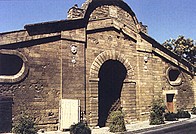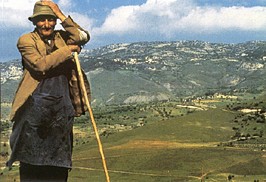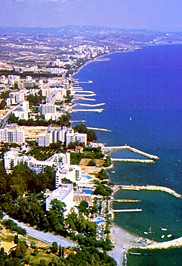|
||||||
|
Regions
Nicosia
“The island has in its midst a fair city called Nicosia, which is the capital of the kingdom, well walled, with its fine gates, which are three, to wit the gate of Paffo, of Famagusta, and Cirina. That of Famagusta, is the most beautiful, and in my judgment the city of Barcelona has none to match it”~ P. Joan Lopez, 1770
During the Venetian expansion eastward in the 1500’s, Nicosia (Lefkosia) was fortified with imposing stone walls and massive gates. The famous Famagusta Gate still stands today, proudly protecting the still-ancient town within from the modern city without. Through the Gate lies Laiki Geitonia, an old section which has been lovingly restored. Wend your way through narrow stone streets where crimson flowers cascade from window pots and the aroma of traditional baking wafts through open doorways. Explore jewelry and handicraft shops, dine in charming tavernas, marvel at churches centuries old. Those engrossed in history and art will make their way directly to the Cyprus Museum, which holds the island’s priceless treasures from the first stirrings of the Neolithic Age through the Roman period. At the Byzantine Museum, encounter a dazzling collection of early-Christian icons from the Mediterranean’s Golden Age. The State Collection of Contemporary Art takes a newer perspective, focusing on Cyprus’ modern artists, some of whom have gained note on the international market. Come full circle in time and visit the Cyprus Handicraft Center workshops, where traditional arts are practiced today much the same way they were in ages past. Relax and enjoy a splendid Cypriot meal, accented by one of the island’s famous wines. Later, the night life beckons near Famagusta Gate, giving expression to the Cypriots’ legendary spirit of celebration. |
|
| Troodos
The thick cedar and pine forests and sun-soaked slopes of the Troodos region offer an unexpected contrast to the Mediterranean coast, less than an hour away. Halfway between the busy towns of Nicosia and Limassol, halfway between sea and sky, rising to 1,950 meters (6,500 feet), Troodos is a counterpoint to the rest of the island. Connecting the mountain resorts of Troodos, Kakopetria, Platres, and Agros are trails that hold delights for mountain bikers, hikers, bird watchers and botanists alike. Signs mark the presence of flora and fauna unique to Cyprus. Glimpses of the blue sea beyond peek through the lace-like canopy of cedar trees. Close enough to touch, herds of grazing moufflon, or agrino — the shaggy mountain sheep indigenous to Cyprus — pass by. And the clear mountain air is fragrant with lemon and orange from the groves below. Happily, a natural reserve in the heart of the region insures that this wild beauty will remain forever. Along the way, each village will be glad to offer you its local specialty, whether that be a mountain goat cheese, a characterful Cypriot wine, fresh cherries, or rosewater. And of course, because you’re still on Cyprus, history and culture are never far away. Nine of Troodos’s remarkable painted Byzantine churches have been listed on UNESCO’s prestigious World Cultural Heritage List. The famous Kykkos and Trooditissa Monasteries are well worth a visit for their icons, frescoes, and inspiring architecture. |
|
|
Limassol
During the Crusades, Richard the Lion-Heart, leader of the Third Crusade, landed in Limassol (Lemesos), not incidentally to free a noblewoman held captive by the Byzantine sovereign. The noblewoman? His betrothed, Berengaria of Navarre. In Limassol they married, touching off the most extravagant party the island had ever seen. Today, the tradition of celebration and hospitality continues in this vibrant seaside town. In February before Lent, masked revelers invade the street with music, parades, and dancing for Carnival. In September, the Wine Festival explodes in the town for a week. And every night people in restaurants, cafés, and nightclubs celebrate events momentous and trivial, from a soccer win to a sudden romance to yet another stunning sunset at day’s end. At 14 km west of Limassol lies Kolossi Castle, a medieval fortress whose walls contain not only an imposing tower and surrounding living quarters but also an ancient sugar factory. Just 19 km west of town, visit the Kourion archaeological site, an ancient city-kingdom, where you can take in a play or concert at the ancient Greco-Roman Theater, overlooking the blue Mediterranean. And, a bit further on, explore a treasure trove of Greek and Roman sites, such as the Sanctuary of Apollo.
|
|
| Larnaca
Most travelers first see Cyprus at Larnaka, which is the second port and the site of an international airport. No welcome could be sunnier: at Larnaka, deep blue seas meet bright sand beaches under incomparably brilliant skies. Here yachts and sailing vessels from around the globe bob and glint, and along the harbor perimeter is a palm-lined promenade. Between shopping trips to Larnaka’s international-caliber boutiques, inviting cafés offer shady resting spots and sweeping ocean views. The promenade winds its way to a striking finale, the Larnaka Medieval Museum, housed in a 17th-century fort. Make your way north from the fort, toward the center of the city, and you will come to one of Larnaka’s and the island’s most cherished sites — the church of St. Lazarus. After his resurrection from the dead by Jesus, Lazarus elected to live out his “second” life as Bishop of Cyprus. He is reputedly buried in a crypt under the main altar. Originally called Kition in the days of the Old Testament, Larnaka reached a heyday as a commercial center in the 1700’s, when the consulates were established here. One of the oldest, continually-inhabited cities in the world, Larnaka abounds with sights. Nearby is an 18th-century aqueduct, and two wonderful museums — the Larnaka District Archaeological Museum and the Pierides Foundation Museum. Both contain exceptional examples of Mediterranean art. Heading out from Larnaka toward Limassol (next section), stop by the enchanting village of Lefkara. Doubtless you, like Leonardo da Vinci five centuries before you, will be seduced by Lefkara’s exquisite handmade lace... |
|
[onlytours.com/includes/footer.htm]




